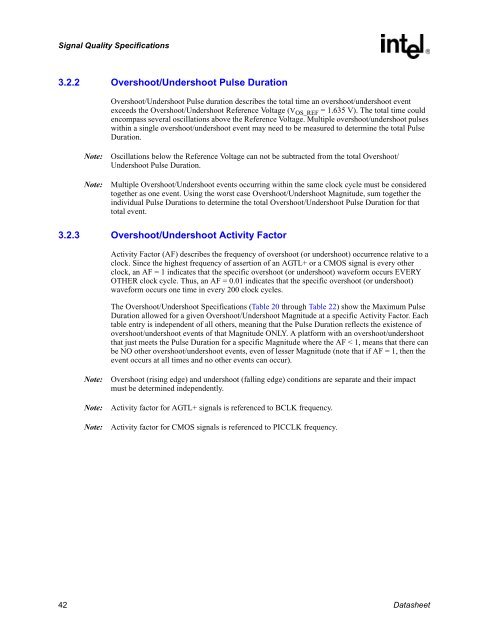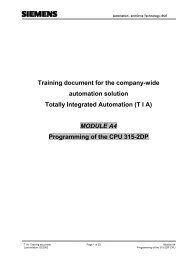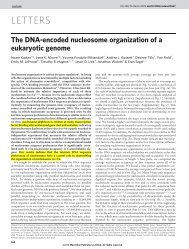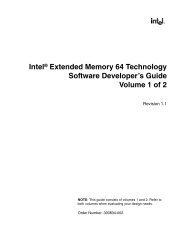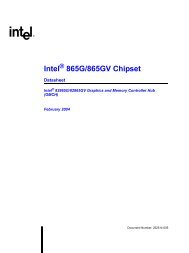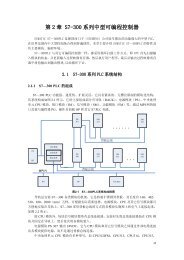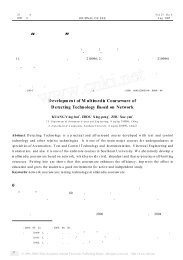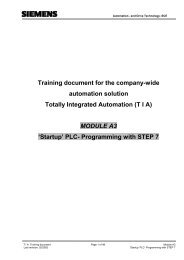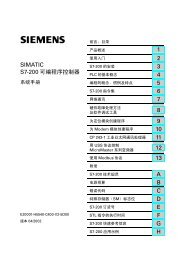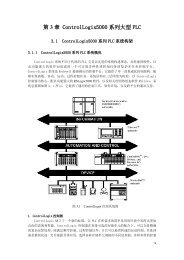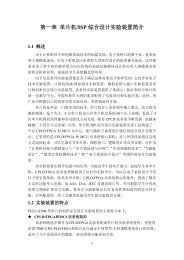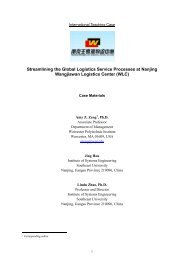Intel Pentium III Processor for the SC242 at 450 MHz to 1.0 GHz
Intel Pentium III Processor for the SC242 at 450 MHz to 1.0 GHz
Intel Pentium III Processor for the SC242 at 450 MHz to 1.0 GHz
You also want an ePaper? Increase the reach of your titles
YUMPU automatically turns print PDFs into web optimized ePapers that Google loves.
Signal Quality Specific<strong>at</strong>ions3.2.2 Overshoot/Undershoot Pulse Dur<strong>at</strong>ionOvershoot/Undershoot Pulse dur<strong>at</strong>ion describes <strong>the</strong> <strong>to</strong>tal time an overshoot/undershoot eventexceeds <strong>the</strong> Overshoot/Undershoot Reference Voltage (V OS_REF = 1.635 V). The <strong>to</strong>tal time couldencompass several oscill<strong>at</strong>ions above <strong>the</strong> Reference Voltage. Multiple overshoot/undershoot pulseswithin a single overshoot/undershoot event may need <strong>to</strong> be measured <strong>to</strong> determine <strong>the</strong> <strong>to</strong>tal PulseDur<strong>at</strong>ion.Note:Note:Oscill<strong>at</strong>ions below <strong>the</strong> Reference Voltage can not be subtracted from <strong>the</strong> <strong>to</strong>tal Overshoot/Undershoot Pulse Dur<strong>at</strong>ion.Multiple Overshoot/Undershoot events occurring within <strong>the</strong> same clock cycle must be considered<strong>to</strong>ge<strong>the</strong>r as one event. Using <strong>the</strong> worst case Overshoot/Undershoot Magnitude, sum <strong>to</strong>ge<strong>the</strong>r <strong>the</strong>individual Pulse Dur<strong>at</strong>ions <strong>to</strong> determine <strong>the</strong> <strong>to</strong>tal Overshoot/Undershoot Pulse Dur<strong>at</strong>ion <strong>for</strong> th<strong>at</strong><strong>to</strong>tal event.3.2.3 Overshoot/Undershoot Activity Fac<strong>to</strong>rActivity Fac<strong>to</strong>r (AF) describes <strong>the</strong> frequency of overshoot (or undershoot) occurrence rel<strong>at</strong>ive <strong>to</strong> aclock. Since <strong>the</strong> highest frequency of assertion of an AGTL+ or a CMOS signal is every o<strong>the</strong>rclock, an AF = 1 indic<strong>at</strong>es th<strong>at</strong> <strong>the</strong> specific overshoot (or undershoot) wave<strong>for</strong>m occurs EVERYOTHER clock cycle. Thus, an AF = 0.01 indic<strong>at</strong>es th<strong>at</strong> <strong>the</strong> specific overshoot (or undershoot)wave<strong>for</strong>m occurs one time in every 200 clock cycles.The Overshoot/Undershoot Specific<strong>at</strong>ions (Table 20 through Table 22) show <strong>the</strong> Maximum PulseDur<strong>at</strong>ion allowed <strong>for</strong> a given Overshoot/Undershoot Magnitude <strong>at</strong> a specific Activity Fac<strong>to</strong>r. Eachtable entry is independent of all o<strong>the</strong>rs, meaning th<strong>at</strong> <strong>the</strong> Pulse Dur<strong>at</strong>ion reflects <strong>the</strong> existence ofovershoot/undershoot events of th<strong>at</strong> Magnitude ONLY. A pl<strong>at</strong><strong>for</strong>m with an overshoot/undershootth<strong>at</strong> just meets <strong>the</strong> Pulse Dur<strong>at</strong>ion <strong>for</strong> a specific Magnitude where <strong>the</strong> AF < 1, means th<strong>at</strong> <strong>the</strong>re canbe NO o<strong>the</strong>r overshoot/undershoot events, even of lesser Magnitude (note th<strong>at</strong> if AF = 1, <strong>the</strong>n <strong>the</strong>event occurs <strong>at</strong> all times and no o<strong>the</strong>r events can occur).Note:Note:Note:Overshoot (rising edge) and undershoot (falling edge) conditions are separ<strong>at</strong>e and <strong>the</strong>ir impactmust be determined independently.Activity fac<strong>to</strong>r <strong>for</strong> AGTL+ signals is referenced <strong>to</strong> BCLK frequency.Activity fac<strong>to</strong>r <strong>for</strong> CMOS signals is referenced <strong>to</strong> PICCLK frequency.42 D<strong>at</strong>asheet


